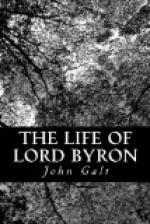They rambled some time through the shaggy woods, with which the country is covered, and the first vestiges of antiquity which attracted their attention were two large granite sarcophagi; a little beyond they found two or three fragments of granite pillars, one of them about twenty-five feet in length, and at least five in diameter. Near these they saw arches of brick-work, and on the east of them those magnificent remains, to which early travellers have given the name of the palace of Priam, but which are, in fact, the ruins of ancient baths. An earthquake in the course of the preceding winter had thrown down large portions of them, and the internal divisions of the edifice were, in consequence, choked with huge masses of mural wrecks and marbles.
The visitors entered the interior through a gap, and found themselves in the midst of enormous ruins, enclosed on two sides by walls, raised on arches, and by piles of ponderous fragments. The fallen blocks were of vast dimensions, and showed that no cement had been used in the construction—an evidence of their great antiquity. In the midst of this crushed magnificence stood several lofty portals and arches, pedestals of gigantic columns and broken steps and marble cornices, heaped in desolate confusion.
From these baths the distance to the sea is between two and three miles—a gentle declivity covered with low woods, and partially interspersed with spots of cultivated ground. On this slope the ancient city of Alexandria Troas was built. On the north-west, part of the walls, to the extent of a mile, may yet be traced; the remains of a theatre are also still to be seen on the side of the hill fronting the sea, commanding a view of Tenedos, Lemnos, and the whole expanse of the AEgean.
Having been conducted by the guide, whom they had brought with them from Tenedos, to the principal antiquities of Alexandria Troas, the visitors returned to the frigate, which immediately after got under way. On the 14th of April she came to anchor about a mile and a half from Cape Janissary, the Sygean promontory, where she remained about a fortnight; during which ample opportunity was afforded to inspect the plain of Troy, that scene of heroism, which, for three thousand years, has attracted the attention and interested the feelings and fancy of the civilized world.
Whether Lord Byron entertained any doubt of Homer’s Troy ever having existed, is not very clear. It is probable, from the little he says on the subject, that he took no interest in the question. For although no traveller could enter with more sensibility into the local associations of celebrated places, he yet never seemed to care much about the visible features of antiquity, and was always more inclined to indulge in reflections than to puzzle his learning with dates or dimensions. His ruminations on the Troad, in Don Juan, afford an instance of this, and are conceived in the very spirit of Childe Harold.




